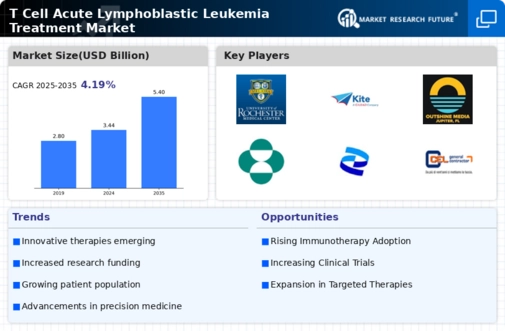Increased Research Funding
The surge in research funding for hematological malignancies, particularly T Cell Acute Lymphoblastic Leukemia, is a crucial driver for the T Cell Acute Lymphoblastic Leukemia Treatment Market. Governments and private organizations are allocating substantial resources to understand the underlying mechanisms of T-ALL and to develop novel therapeutic strategies. In recent years, funding initiatives have led to the establishment of specialized research centers focused on T-ALL, fostering collaboration among scientists, clinicians, and pharmaceutical companies. This collaborative environment is likely to accelerate the pace of discovery and innovation in treatment options. As a result, the T Cell Acute Lymphoblastic Leukemia Treatment Market is expected to benefit from a pipeline of new therapies emerging from this increased investment in research.
Advancements in Gene Therapy
Recent advancements in gene therapy are significantly influencing the T Cell Acute Lymphoblastic Leukemia Treatment Market. Innovative approaches, such as CAR T-cell therapy, have shown promising results in treating T-ALL, leading to improved patient outcomes. The success of these therapies has prompted increased investment from biotechnology firms and research institutions, aiming to refine and expand gene therapy applications. As of 2025, several gene therapies have received regulatory approvals, enhancing their availability to patients. This trend is expected to continue, with ongoing clinical trials exploring new gene-editing techniques and their efficacy in T-ALL treatment. The potential for personalized medicine through gene therapy is likely to reshape the treatment landscape, driving growth in the T Cell Acute Lymphoblastic Leukemia Treatment Market.
Rising Demand for Combination Therapies
The rising demand for combination therapies is shaping the T Cell Acute Lymphoblastic Leukemia Treatment Market. Clinicians are increasingly recognizing that a multi-faceted approach may enhance treatment efficacy and reduce the risk of relapse in T-ALL patients. Combination therapies, which may include chemotherapy, targeted agents, and immunotherapy, are being explored in clinical trials, demonstrating improved outcomes compared to monotherapy. This trend is likely to drive pharmaceutical companies to develop and market combination treatment regimens tailored to T-ALL. As the understanding of T-ALL biology evolves, the T Cell Acute Lymphoblastic Leukemia Treatment Market is expected to see a shift towards more integrated treatment strategies, potentially leading to better patient prognoses.
Growing Awareness and Education Initiatives
Growing awareness and education initiatives regarding T Cell Acute Lymphoblastic Leukemia are pivotal for the T Cell Acute Lymphoblastic Leukemia Treatment Market. Increased public and professional education about T-ALL symptoms, treatment options, and the importance of early intervention is likely to lead to higher diagnosis rates. Non-profit organizations and healthcare providers are actively engaging in campaigns to disseminate information, which may empower patients and families to seek timely medical attention. This heightened awareness can result in a larger patient population requiring treatment, thereby driving demand within the T Cell Acute Lymphoblastic Leukemia Treatment Market. As awareness continues to grow, it is anticipated that more resources will be allocated to research and treatment options, further enhancing market dynamics.
Growing Incidence of T Cell Acute Lymphoblastic Leukemia
The rising incidence of T Cell Acute Lymphoblastic Leukemia (T-ALL) is a primary driver for the T Cell Acute Lymphoblastic Leukemia Treatment Market. Recent statistics indicate that T-ALL accounts for approximately 15 to 20 percent of all acute lymphoblastic leukemia cases, with a notable increase in diagnoses among adolescents and young adults. This trend necessitates the development of effective treatment options, thereby propelling market growth. The increasing awareness of T-ALL symptoms and the importance of early diagnosis contribute to higher detection rates. As healthcare systems enhance their diagnostic capabilities, the demand for innovative therapies is likely to rise, further stimulating the T Cell Acute Lymphoblastic Leukemia Treatment Market. Consequently, pharmaceutical companies are investing in research and development to address this growing patient population.


















Leave a Comment